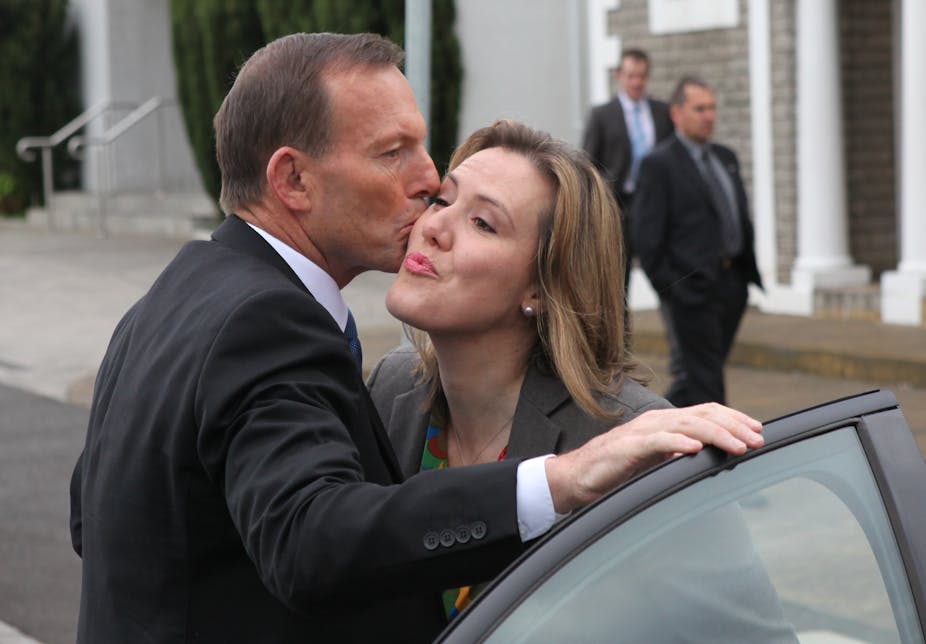In a discussion with ABC journalist Emma Alberici on Lateline last week, Liberal MP Kelly O’Dwyer defended Tony Abbott from attacks by Labor ministers who criticised his attitudes towards women. In the process, O’Dwyer claimed that “what we’re seeing for the very first time in Australian political history is gender being used as a political weapon”.
However, O’Dwyer is being disingenuous to say the least. In fact, there is a long history of gender being used as a political weapon in Australian politics, including by the Liberal Party. The difference is that normally gender is used as a subtext rather than being explicitly talked about. After all, gender was being used as a political weapon when John Howard and Peter Costello depicted Kim Beazley as “flip-flop” Beazley who lacked the “ticker’ to make the tough decisions to protect Australia and keep the economy strong.
In other words, they suggested that Beazley wasn’t man enough. Gender was being used as a political weapon when Tony Abbott suggested that Kevin Rudd was "all talk and no action” – in other words that Rudd was an ineffectual nerd who wouldn’t deliver the policy changes necessary, unlike that real man, Tony Abbott. Gender was also being used as a political weapon in the 2004 election when the Liberals suggested that Mark Latham was a dangerous, aggressive, potentially violent rogue male and that it wasn’t safe to put the country in his hands.
In other words in 2004 the Liberals used a gender strategy against Latham that has some similarities to the strategy currently being used by against Tony Abbott by Labor.
Of course, such strategies aren’t confined to one side of politics. Latham himself was a master of using both gendered and heterosexist subtexts that belittled the masculinity of his opponents, including by casting aspersions on whether they were red-blooded heterosexual males. So Howard became an “arse-licker” towards the US; Peter Costello was likened to Gary Glitter and Latham suggested that “maybe Doug Cameron was right. The fellow that Abbott beat in the boxing final at Oxford went on to be the director of the Royal Ballet in London.”
Meanwhile, Julia Gillard herself notoriously once described Christopher Pyne as “mincing” and a “poodle” compared with Abbott’s “macho” “doberman”, thereby managing to cast aspersions on both men’s forms of masculinity.
However, above all, Kelly O’Dwyer was being disingenuous because, as I’ve explained previously in The Conversation, the Liberals have consistently used gendered subtexts against Julia Gillard.
There have been repeated Liberal party suggestions that Julia Gillard is a vicious and devious “Lady Macbeth” type figure who knifed Kevin Rudd. While there are legitimate questions that can be asked about both the justification for, and timing of, Rudd’s removal, it is interesting that women who successfully challenge existing leaders seem to be constructed differently from male politicians who do so.

For example, Paul Keating did not receive the same level of personal opprobrium for successfully challenging Bob Hawke and neither did Tony Abbott for successfully challenging Malcolm Turnbull. Yet both gained their positions by removing previous male leaders, as so many of their male predecessors have done before.
Furthermore, Tony Abbott constantly uses gender subtexts against Julia Gillard. For example, he has repeatedly implied that, as an unmarried woman who has not given birth, Julia Gillard can’t empathise with ordinary Australian families. That is why Abbott started the 2010 leaders debate by declaring: “my wife, Margie, and I know what it’s like to raise a family, to wrestle with a big mortgage, with grocery bills and school fees”.
It is also why he alluded to Julia Gillard’s unmarried state by claiming that: “Only an election could make an honest politician of this Prime Minister”. It is also why, during the 2010 election campaign, Abbott was continually depicted with his wife and daughters. Indeed , Margie Abbott’s own impassioned speech defending her husband from sexism chances was entitled “The Joy of an Ordinary Life” and itself had a subtext that repeatedly counterposed her “ordinary” married family life to that of Julia Gillard’s.
In addition, as Labor MP Andrew Leigh pointed out when responding to Kelly O’Dwyer’s comments, Tony Abbott has a habit of repeatedly referring to Julia Gillard as “SHE” in parliament. This usage seems to be spreading into popular discourse as “SHE” is commonly blamed in everyday conversation and talkback radio for everything ranging from higher electricity prices to higher penalty rates in the hospitality industry.
So, contrary to Kelly O’Dwyer’s statement, gender has long been used as a political weapon in Australian politics. What is perhaps different is that, particularly since the Prime Minister referred to “sexist” and “misogynist” online attacks on her, the use of gender as a political weapon is now being more explicitly articulated, rather than gender issues being evoked via subtexts. Interestingly, Attorney-General Nicola Roxon suggested on the ABC’s Insiders that Kelly O’Dwyer’s reference to a “handbag hit squad” was an attempt to suggest it was illegitimate for senior female ministers to openly discuss sexism in politics, including the sexist behaviour that Roxon claimed she had personally experienced from Tony Abbott.
It certainly seems hypocritical for the Liberals to be complaining about Labor’s use of the gender card against Tony Abbott, when they have so skilfully played the gender card against Julia Gillard.

